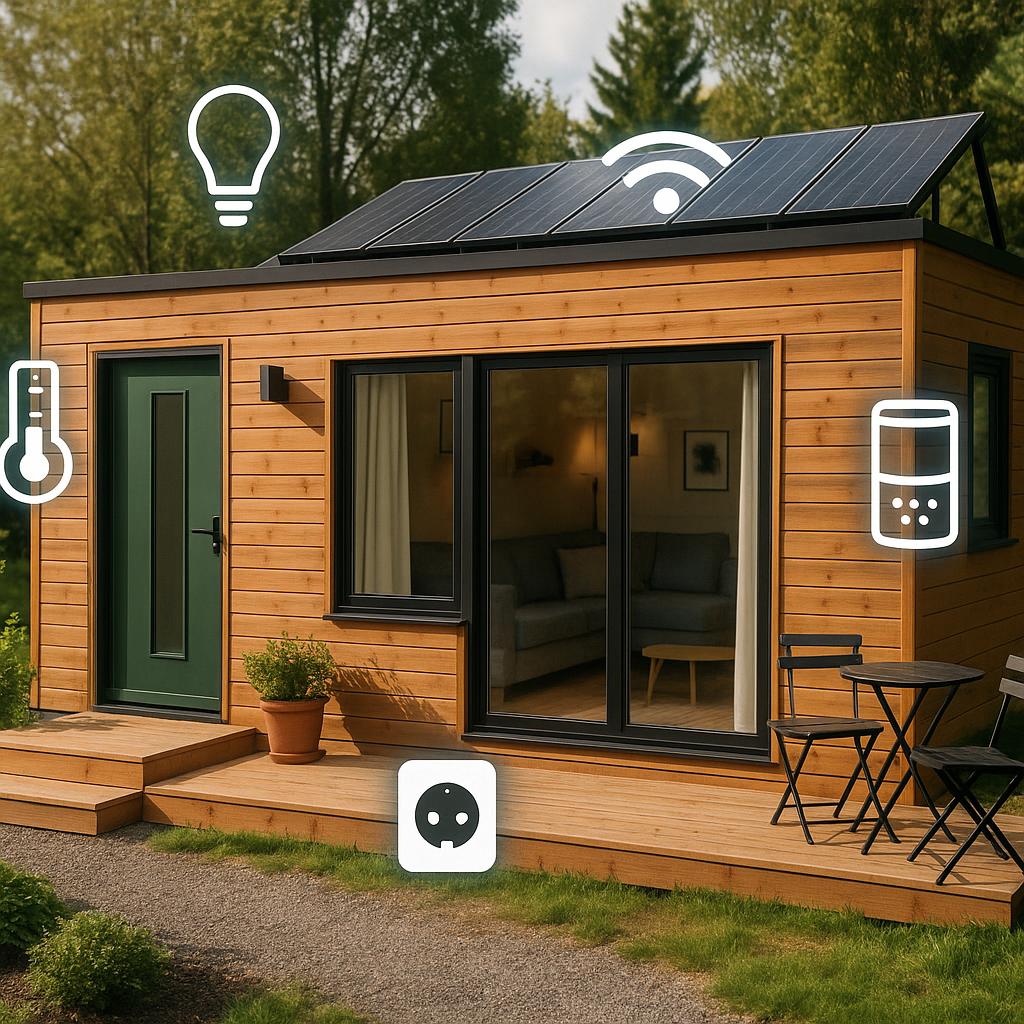
Tiny Home Automation: Smart Tech Transformations for Canadian Tiny Homes & ADU Upgrades in 2025
Estimated reading time: 8 minutes
Key Takeaways
- Compact Living Revolution: Tiny home automation is transforming the way Canadians approach renovation by integrating smart tech for enhanced efficiency.
- Energy & Space Efficiency: Upgrading tiny homes and ADUs focuses on modernizing interiors and maximizing every square foot.
- Smart Tech Integration: From motion-activated lighting to learning thermostats, smart systems improve security, comfort, and cost savings.
- Unified Control Systems: Home automation platforms ensure seamless compatibility, scalability, and user-friendly remote management.
- Real-World Impact: Case studies and practical examples prove that integrating smart tech leads to significant energy savings and optimized space usage.
Table of Contents
- Tiny Home Renovation & ADU Upgrade Basics: Smart Tech for Small Spaces
- Must-Have Smart Tech Upgrades for Tiny Home Automation in 2025
- Home Automation Systems: Integration & Compatibility for Tiny Home Renovation
- Boosting Convenience & Efficiency: Tiny Home Automation Tactics for 2025 Trends
- Case Study: Vancouver ADU Upgrade with Tiny Home Automation & Smart Tech
- Future Trends & Final Thoughts: Tiny Home Automation in 2025 and Beyond
- Start Planning Your Tiny Home Automation or ADU Upgrade Now
- Frequently Asked Questions
Tiny Home Renovation & ADU Upgrade Basics: Smart Tech for Small Spaces
Tiny home automation is quickly becoming a must-have for Canadian homeowners embarking on tiny home renovation or ADU upgrade projects. As compact living surges in popularity, 2025 trends in smart tech and home automation are changing the game—helping Canadians build smarter, more efficient, and more comfortable homes even in the smallest spaces. Learn more about Building a Smarter Canadian Home in 2025 and explore Popular Tiny House Design Trends.
A tiny home in Canada is usually under 400 square feet. These compact dwellings can be on wheels or foundations and are celebrated for their flexibility and environmental benefits. An ADU (Accessory Dwelling Unit) is a self-contained residential space built on the same lot as a primary home—think backyard suites, garage apartments, or laneway houses. ADUs are gaining traction in urban areas as cities seek to increase housing supply while preserving livability.
Common Renovation Goals for 2025:
- Modernize interiors while maximizing available space.
- Improve insulation and ventilation to withstand Canadian weather.
- Replace outdated infrastructure with eco-friendly materials.
- Integrate smart tech systems to boost efficiency, safety, and comfort.
Renovation Challenges in Small Spaces:
– Limited storage without creating a cramped feel.
– Efficient energy management in minimal space.
– Overcoming physical barriers to installation.
How Smart Tech Solves These Problems:
– Combines multiple features into compact solutions.
– Enables remote and voice-activated control, freeing up wall space.
– Automatically fine-tunes energy usage.
– Enhances security and comfort without clutter.
Additional insights from experts can be found via Top 7 Smart Home Technology Trends to Watch in 2025 and Tiny Home Living Guide.
Must-Have Smart Tech Upgrades for Tiny Home Automation in 2025
Integrating smart tech is central to tiny home automation. Here’s what should top every Canadian’s upgrade list for 2025:
Smart Lighting Systems
- Motion or occupancy-activated LED lights: Save power and eliminate the need for numerous manual switches.
- Programmable schedules ensure lights adjust automatically—dimming at night and brightening in the morning.
- Wireless, app-based controls allow placement of fixtures for optimal use, not merely based on wiring convenience.
- Fitted discreetly into ceilings or furniture to maintain ample headroom and design flow.
Learning Thermostats & Mini-Split HVAC
- Smart thermostats learn your preferences and automatically adjust heating and cooling.
- Mini-split HVAC units save space when traditional ductwork isn’t feasible.
- Together, they optimize comfort, reduce utility bills, and adapt to occupancy patterns.
Smart Security Solutions
- Wi-Fi-enabled door locks, compact cameras, and connected alarms secure your property.
- Receive remote notifications or unlock doors via mobile even when away.
- Discreet designs ensure maximum use of your living space.
Compact Multi-Functional Appliances
- Appliances designed for tiny living, like combination washer/dryers, moveable induction cooktops, or fold-out kitchen units.
- These appliances consolidate functions, preserving storage space.
Innovations: Unified Automation & AI
- AI-driven personalization anticipates your routines, adjusting settings like blinds or climate control automatically.
- Multi-user voice recognition personalizes settings for all household members.
- Unified platforms control lights, security, and appliances from a single app or smart speaker.
- Enhanced energy management tools integrate with renewable energy sources, such as solar panels.
For more details, check out Popular Tiny House Design Trends and revisit Smart Home Technology Trends.
Home Automation Systems: Integration & Compatibility for Tiny Home Renovation
Selecting the right home automation system is especially critical in limited spaces. Consider these factors:
Device Compatibility & Interoperability
- Ensure your devices – including lighting, thermostats, and security systems – are compatible with major platforms like Apple HomeKit, Google Home, or Amazon Alexa.
- A unified system avoids the hassle of juggling multiple apps.
Scalable, User-Friendly Control
- Select systems that can easily grow with your needs by adding new smart plugs, sensors, or voice devices.
- Systems with simple setup and intuitive controls save time and reduce frustration.
Integration Challenges & Solutions
- Physical Constraints: Place hubs and devices where they best reach signals; consider low-profile designs.
- Connectivity: Use mesh Wi-Fi or signal boosters to eliminate dead spots in divided layouts.
- Device Updates: Regular firmware updates and compatibility checks can keep your system running smoothly.
Explore additional tips from experts at Tiny Smart Home in Canada and Eco-Friendly Home Strategies.
Boosting Convenience & Efficiency: Tiny Home Automation Tactics for 2025 Trends
Automation plays a key role in optimizing every square foot. Here are several practical tactics:
Maximizing Space with Automation
- Automated storage solutions: Motorized shelving, under-bed drawers activated by voice commands, and lift-up kitchen surfaces can all be managed via smart apps.
- Convertible smart furniture: Beds that fold into walls, tables that transition into desks, and couches that slide away help retain valuable space.
Routines, Voice Control & Remote Management
Program routines for “morning” or “night” that switch off lights, secure doors, and set the climate with a single command. Remote management from anywhere enhances convenience while reducing the need for physical wall switches.
Energy Efficiency through Automation
Smart thermostats and occupancy sensors adjust climate zones automatically, while integration with solar and battery systems ensures optimal energy usage. Lights and plugs can be set to power down when not in use, further lowering utility bills.
For further insights, visit resources like Building a Smarter Canadian Home in 2025 and the Tiny Home Living Guide.
Case Study: Vancouver ADU Upgrade with Tiny Home Automation & Smart Tech (2025 Trends)
In 2025, a Vancouver homeowner transformed a 350-square-foot ADU by integrating cutting-edge tiny home automation and smart tech upgrades.
Project Details
- Installed a single AI-powered automation platform compatible with multiple smart brands.
- Utilized occupancy sensors to automate lighting, heating, and security features.
- Employed a mini-split HVAC paired with a smart, learning thermostat.
- Incorporated a Murphy bed with both a wall switch and voice control activation.
Before Automation
- High utility bills from inefficient heating systems.
- Manual lighting and door locks often resulted in energy waste and security concerns.
- Clutter and cramped spaces due to static furniture setups.
After Automation
- Energy costs dropped by approximately 30% due to tighter control over climate and lighting.
- Remote and voice-activated controls simplified daily management.
- Space was optimized with multi-functional, convertible furniture, freeing up valuable living area.
- Enhanced security with smart cameras and remote door locks provided peace of mind.
This real-life example highlights how tiny home automation can drive significant savings and functional improvements. More case studies can be explored at ADU Investment Canada Guide and ADU Income Case Studies in Canada.
Future Trends & Final Thoughts: Tiny Home Automation in 2025 and Beyond
Adopting tiny home automation and smart tech brings substantial rewards:
- Energy Efficiency: Lower utility bills and a smaller carbon footprint.
- Unmatched Convenience: Voice commands, routines, and mobile management save time and hassle.
- Advanced Security: Integrated systems offer robust protection without intrusive devices.
- Optimized Space: Replace bulky devices with sleek, multi-purpose appliances.
- Increased Property Value: Future-proof, integrated homes are highly attractive in the market.
Looking ahead, expect AI-Driven Platforms that personalize your home environment, expanded integration with renewable energy, and innovative appliances that further optimize small space living. For more futuristic insights, read about Smart Home Technology Trends and strategies on Eco-Friendly Home Canadian Strategies.
Start Planning Your Tiny Home Automation or ADU Upgrade Now
If you’re contemplating a tiny home renovation or ADU upgrade, now is the time to explore 2025’s most exciting smart tech trends. Begin by researching which automation systems align with your unique layout and needs.
Take Action:
- Identify and compare smart tech systems tailored for compact spaces.
- Consult experts specializing in home automation and small-space renovations.
- Invest in modular, scalable solutions that grow with your lifestyle.
Ready to get started? Explore detailed guides such as Building a Smarter Canadian Home in 2025, Popular Tiny House Design Trends, and Top 7 Smart Home Technology Trends to map out your smart, sustainable upgrades.
Frequently Asked Questions
-
Q: What makes tiny home automation essential for Canadian homes?
A: It transforms compact living by integrating energy-efficient, space-saving smart tech, enhances security, and simplifies daily routines. -
Q: How can smart tech improve energy efficiency in an ADU or tiny home?
A: Features like learning thermostats, occupancy sensors, and automated lighting adjust energy usage based on occupancy and time of day, leading to reduced utility costs. -
Q: Are there scalable solutions for integrating home automation in small spaces?
A: Yes, many automation systems offer modular components that can be expanded over time, ensuring compatibility and ease of control. -
Q: Can converting to a smart home increase resale value?
A: Absolutely! Future-proof, energy-efficient homes are more attractive to buyers and can boost property value. -
Q: What are the primary challenges of installing smart tech in tiny spaces?
A: Key challenges include limited space for devices, ensuring robust connectivity, and maintaining aesthetic appeal while integrating advanced functionalities.

Leave a Reply